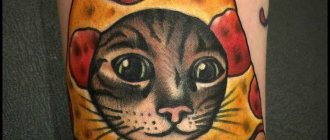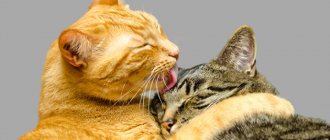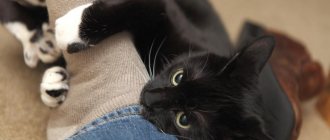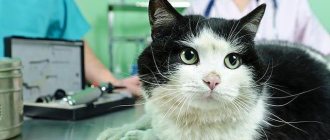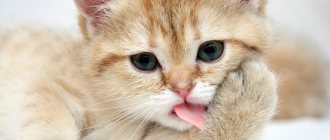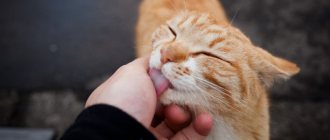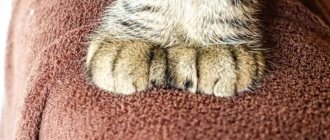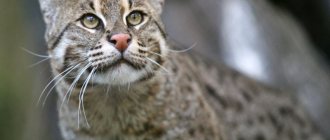Physiology of purring
First, let's figure out how and why cats make such sounds, which we call purring. Experts say that this is determined by a number of features, because only representatives of this family have this property .
1 version . Impulses from the brain transmit signals to the vocal cords, which cause their vibrational contractions. For us it is heard that the pet is purring. If the cat opens its mouth at this time, it will produce a normal “meow.”
Version 2 . Air flow movement. Scientists say that the ability of cats to purr as they inhale and exit is the result of the circulation of air entering the lungs.
Version 3 . A slightly implausible assumption, but it also has a place - cats can force the blood flow to circulate through large vessels so that a special vibration occurs in the skull. It is she who gives that sound.
It is noted that the sound vibration from a cat purring is a kind of training for both blood vessels and muscles. The furry sloth needs it so much.
My cat doesn't purr. This is problem?
Contents hide
My cat doesn't purr. This is problem?
We don’t know how to answer this question literally in two lines. Many of us, in fact, get cats expecting to hear this enchanting and completely inimitable sound. Modern science has proven that a cat's purring is good for our health! Let's not go into theory. Just know: if your cat (or, alternatively, you) sits comfortably and starts singing its magic song, it means that your body’s healing session has begun! Isn't this a miracle!
In general, you don’t have to be a great scientist. In one of our recent articles, we pointed out: a cat on your lap is the strongest anti-stress. Any cat lover will confirm the correctness of these words! All problems in some incomprehensible way evaporate when you stroke and scratch your furry pet.
How do cats purr? Until recently, experts were at a loss. According to one theory, the characteristic rumbling sound was formed by the reverberation of blood in the animal's chest. Now the prevailing opinion is that when inhaling and exhaling, the cat simply uses a special group of muscles, which, by vibrating, contribute to the formation of sounds known to us all. Plus a special technique of circular breathing. It's not that simple!
Why do cats purr? It all starts in early childhood! “Mom, I want milk!” The kittens get what they want and purr sweetly with pleasure. This behavior pattern is also inherited by adult animals - let’s call it “Purring as a request.” For example, a pet came up to you, rubbed itself against your legs and purred loudly. The translation, we hope, is clear to everyone - it's time to put the food in the bowl, dear man! Friendly cats often purr when communicating with each other.
But purring is not always a sign of joy or contentment of the animal. Thus, some experts note that cats can purr in moments of aggression, before an attack. Both sick and injured animals begin to purr. Scientists quite rightly believe that healing powers are hidden in purring.
But here’s the problem – your cat “doesn’t know how” to purr. No matter how hard the owners try, they can’t get the cherished sounds out of their pets. Why is this happening? Let’s trust the experts: it is not at all necessary to assume that the pet “can’t do it” or is “not trained.” Perhaps the cat simply does not see the need to purr - she has other means in her arsenal for communication. Vocalization, such as facial expressions or body language. Some cats purr very quietly, “intelligently”, almost inaudibly. Just try to listen! Or gently place your hand on the animal's chest: most likely, you will feel a characteristic vibration.
Some cat lovers notice that kittens born from feral mothers practically do not purr. This, of course, does not always happen. But there is a logical explanation for everything: mothers themselves teach their babies to be “quiet” so as not to attract attention to themselves once again.
So no need to worry if your pet has been “silent” since kittenhood. It’s just that you got such a quiet person... It’s a shame, but, as they say, nothing can be done. If your pet was previously “talkative”, but is now suspiciously quiet, make an appointment with the veterinarian. To, so to speak, dispel all doubts.
Based on materials: Why Doesn't My… Cat Purr? Author: Dr. Marty Becker Source: vetstreet.com Photo: pixabay.com
What does purring mean?
An interesting fact is that the vibrating sound made by cats is the result of several factors.:
- manifestation of emotions. The kittens signal to the cat that everything is fine. Then the adult purrs and thereby tries to tell the owner about it,
- an expression of pleasure. This is a kind of sign of gratitude for delicious food, comfort and affection. In general, being in a good mood can be a reason to purr under your breath,
- calmness. This is a way to calm down after suffering stress, especially when stroked by the owner. After all, the kitten purrs when sucking its mother’s milk and this is a natural process. Therefore, an already adult cat calms down from the sound of its purring. Sometimes in this way he prepares himself for sleep. Then there is no loud purring, rather it will be quiet,
- a sign of threat or a mood to hunt. Purring can not only be kind and affectionate, it can sound quite aggressive. This is how the cat makes it clear that this is his territory. The hunter guarding the birds purrs loudly, tuning in to the hunting process.
If a cat never purrs, it may be due to his personality. Some individuals, like people, simply do not like to show emotions.
Why do cats purr?
There are several versions of why a cat in some cases does not meow, but purrs loudly:
- Kittens use this way of expressing emotions to communicate with their mother. By meowing or purring loudly, they tell the cat that everything is okay. This is especially important for wild breeds at night, when the adult animal goes hunting, leaving the babies.
- Peace. You may notice that kittens purr constantly when they suck their mother's milk. This is how they express their satisfaction, because it is impossible to suck and meow loudly at the same time. The cat also begins to purr at such moments, calming its cubs.
- Gratitude. A kind word, stroking, or a tasty treat can make your pet purr loudly to express his gratitude. In this case, a quiet “rattle” is a sign of contentment with the cat’s life and a full stomach.
- A way of expressing emotions. According to one version, a cat's purring can be compared to human singing. With the help of uniform cyclical sounds emitted with different volumes and intensities, the animal expresses the various feelings that prevail at a particular moment. People hum to themselves in the same way.
- Restoring health during illness or after suffering stress. Vibrations produced at a certain frequency stimulate blood circulation and activate metabolic processes in the body. This way the animal can warm up if it is very cold, or calm down after a strong fright. In this case, it is better not to distract your pet from such an important process as purring.
- Acquaintance. When meeting another individual, the cat begins to purr loudly, showing its good-natured attitude. Healthy and strong males meow to show weaker rivals that they are not going to attack.
- A cat can purr loudly if it wants to get something from its owner: a portion of food or affection, a piece of delicious sausage. Sometimes pussies just ask to be held in your arms or let into a warm master's bed. Fluffies like to use this technique even at night, so it is better for the owner not to indulge in these tricks.
- Fear. A very frightened cat purrs loudly, asking not to be hurt.
- Achieving spiritual harmony. The animal begins to purr most often before going to bed. Measured sounds help him calm down and tune in to the right mood. Veterinarians say that at this time it is impossible to listen to the pet’s heart and lungs, the vibrations in the body spread so strongly. This preparation helps tailed singers get a better night's sleep.
- Self-defense. Animals make an angry, threatening purr when they are protecting their food or territory. If you touch your pet at such moments, you can get a painful blow with your paw.
- Manifestation of the hunting instinct. A quiet, concentrated purr can be heard when the pet sits on the window and watches the flying birds.
We recommend reading: Reasons why Dogs Frequently Want to Eat
These are the main versions of why cats purr. It is worth noting that all pets make sounds at a frequency of 25 cycles per minute, no more and no less. This does not depend on the breed and size of the animal.
The cat doesn't purr
The absence of such sounds from a cat may not only be the result of heredity. Often it occurs due to character traits or a manifestation of resentment towards the owner. Perhaps this is a consequence of distrust of a person, a feeling of discomfort, a feeling that he has become superfluous in the family.
Often a cat does not purr and begins to behave this way after the arrival of a small child in the family. To attract attention to herself, she begins to do dirty tricks, which she has not done before. But the owners' reaction to this may be negative. Try to understand the reason for this behavior and show your pet patience and affection. Then the situation may change and you will again hear him purring gratefully.
1 version . Impulses from the brain transmit signals to the vocal cords, which cause their vibrational contractions. For us it is heard that the pet is purring. If the cat opens its mouth at this time, it will produce a normal “meow.”
Why does a cat purr and what does it mean?
Most owners believe that purring is associated with satisfaction with life, because a cat often purrs when you stroke it. It turns out there are other reasons:
- Vibration supports good health, improves blood circulation, promotes energy and activity.
- When a mother purrs and lulls her babies to sleep, she shows them that everything is fine, there is no reason to be afraid.
- The animal expresses gratitude to you for your affection or tasty treat.
- The pet requires attention to itself, and the sound may be accompanied by persistent rubbing against the legs.
- Sometimes this is associated with pain - the cat is trying to calm itself down by relieving tension. The calming effect is due to memories of the mother - when she made a sound, everything was okay.
- When they see their brothers, cats rarely purr, but in this way they try to show that they are peaceful and do not want to start conflicts. Most often, the dominant, stronger cat purrs.
- Your pet just got bored - remember how you returned home and he started actively singing his song? He just missed you.
- The reason may be a stressful situation: this is how in the veterinary office the baby calms himself down, tries to maintain balance, because he has enough reasons to panic.
We recommend reading: Chickens wheeze Diseases Treatment
Why do cats purr?
How, why and why cats purr is not known for certain. However, there are several theories on this matter, and scientifically based ones.
It is believed that a cat's purring is the result of the generation of electrical impulses in its brain. They are transmitted through the central nervous system and lead to the contraction of certain muscles that are located near the vocal cords. The purring apparatus itself consists of thin bones connected to each other, which go from the base of the skull to the base of the tongue. These bones are called hyoid bones. When a cat purrs, the vocal cords vibrate and thus cause resonance in the hyoid bones.
We recommend reading: Paralysis When Dogs Are Poisoned
Any cat is capable of purring both while inhaling and exhaling. Moreover, only small representatives of the cat family purr - cats, lynxes, etc. In large cats, such as tigers, lions, leopards, the hyoid bones are covered from above with dense cartilage up to the skull. They prevent the hyoid bones from vibrating, however, due to the fact that such cartilage strengthens the entire vocal apparatus, the largest of the cats, the lion, can roar loudly. Moreover, only lions are truly capable of roaring; other big cats can grumble, howl, hiss, and even cough and grunt, but not purr.
It is believed that purring was originally used by small kittens to tell their mother that everything was fine and good. You may notice that kittens almost always purr while feeding. After all, it is impossible to suck milk and meow at the same time, but you can purr as much as you like. At the same time, mother cats also often purr, thus encouraging the kitten or calming it down.
Older cats may purr when they meet other cats to show their friendly intentions and desire to play. Dominant
Source
At what age do kittens begin to purr?
Everything here is individual: there are kittens that can purr after birth - at one day of age. They do this, feeling maternal protection, love and delicious milk. Others take several weeks or months to learn. There are cats that can purr from 6 or 11 months, and there are those that will never do this - you will not be able to determine the baby’s character and preferences in advance.
Note! Not only is everyone’s age different, but the frequency of sounds is individual - some individuals constantly sing a song, while others find it difficult to hear a pleasant sound, even if they feel very good.
If your cat's purring suddenly stops, you should look for the reason. Perhaps the baby has some health problems, he feels weak and unwell. Source: Flickr (Vasquezz)
Where exactly does the purring sound come from in cats and how to learn to purr
The property of purring is unique: it appears only in cats of any size - other animals cannot please their owners so much. To understand how cats purr, you need to turn to the study of the physiological features of the mechanism. Nerve impulses are formed in the brain, which give a signal to the vocal cords for subsequent contraction. What do cats purr? Between the skull and the uvula, nature has installed a special organ: thin, interconnected bones. Muscle contraction provokes a vibration that emanates from the nose and mouth, spreading throughout the body.
This is interesting! While the kitten is purring, it is impossible to hear its heartbeat, which is why veterinarians wait until your pet stops this activity to begin the examination.
Some owners want to learn to purr in the same way as their pet. The desire is due to pleasant notes and the opportunity to please the pet: communicating with him in the same language is already happiness. For the learning process, you need to have the animal nearby and have a friendly relationship. As soon as the kitten starts making a sound, breathe through your nose without opening your mouth, try to repeat the melody. It will seem difficult at first, but a few hard workouts will yield results. Moreover, you can please your friends with it and make them laugh.
Why a cat might stop purring and why some cats don't purr
If your cat's purring suddenly stops, you should look for the reason. Perhaps the baby has some health problems, he feels weak and unwell. Sometimes the reason is global changes in the house: you got a dog or a child. The cause is resentment when the lump is not happy with something, it is sad or tense. Cats are also very sensitive to changes in attitude: if you love him less, the purring may stop.
Some cats refuse to purr at all: they know how to do it, they just don’t show their emotions to other people. Silence is due to character traits, this does not mean that the animal is bad, lacks affection - everything is individual, just like with people.
Now you know why cats purr. All owners love this sound: it is not only pleasant to the ear, but also has a healing effect. Every cat has this skill, but not everyone uses it often. The owner can also learn to purr - this requires training.
Video on the topic
Some owners want to learn to purr in the same way as their pet. The desire is due to pleasant notes and the opportunity to please the pet: communicating with him in the same language is already happiness. For the learning process, you need to have the animal nearby and have a friendly relationship. As soon as the kitten starts making a sound, breathe through your nose without opening your mouth, try to repeat the melody. It will seem difficult at first, but a few hard workouts will yield results. Moreover, you can please your friends with it and make them laugh.
Did you know...
There are several interesting facts related to purring cats.
- Biologists have found that not only pets can make such sounds. Some species that live in the wild can also purr: cheetahs, ocelots, jaguars, servals and lynxes. The rest of the predators can be classified as snarling, but this classification is conditional. Only lions truly roar, and the volume of their powerful roar reaches a record 114 decibels. The rest of the wild pussies hiss and howl.
- There are unique ones in the cat family - these are individuals that can both meow and purr at the same time. Thus, they communicate not only with humans, but also with representatives of their own species. Although a cat’s arsenal contains about a hundred different sounds for communication (for comparison, dogs use no more than 10). Some zoologists have even been able to identify analogues of the human sounds M, N, R, V, X, G, F in the “speech” of cats.
- There are known facts when pets, living next to people for a long time, imitated entire words with their purring. Of course, these were fairly simple monosyllabic expressions, but the fact in itself is amazing.
- Cats begin to purr and meow only when alone or in the presence of a person. If two domestic animals are in the same room, they do not use these sounds to communicate with each other.
- Another interesting feature. The beneficial effect of purring extends not only to the pets themselves, but also to those people who hold them in their arms. The frequency of the sound wave in the purring cycle varies smoothly from 25 to 150 Hz. These changes are cyclical and affect the nervous system and blood circulation of a person. The owner of a singing pet has a universal and absolutely harmless sedative. It is enough to take the pussy in your hands and lightly scratch it behind the ear. The headache, fatigue go away, the heartbeat normalizes, and sometimes the blood pressure can be stabilized.
We recommend reading: The cat is drooling because of a pill, what to do?
It doesn't matter why cats purr or meow softly. In this way they can express many emotions, which only a caring and loving owner can understand. You should only be wary if your pet has stopped doing this.
Cats are able to cause blood in the vessels of the throat and chest to circulate in a special way, causing vibrations. These vibrations resonate in the sinus cavities inside the skull and are converted into sound waves.
How and why do cats purr?
The measured purring of a graceful cat heals the soul, dispelling sorrows and filling reality with calm and optimism. Feeling the light vibration of the cat’s body with your fingertips and listening to the gentle rattling, you believe that everything will certainly be fine. You can wonder for a long time why cats purr and what the purpose of this sound is. But some mysterious haze only enhances the effect of the healing rumbling.
Where is “murrr-murrr” born?
Until recently, zoologists did not understand how cats purr. It was believed that rumbling is the result of vibrations of the diaphragm or trachea, and someone even put forward the theory that cats purr... with their stomachs! The reason why scientists could not figure out which organ cats purr with turned out to be trivial - all studies were carried out on immobilized animals by examining a “non-functioning rattle”.
After zoologists from New Orleans changed tactics, the veil of secrecy was lifted. Natural studies using the latest ultra-sensitive sensors and microphones have revealed how cats actually purr. It turns out that in a cat’s throat there are “false” vocal cords - two movable folds that work both on exhalation and inhalation. The mucous membranes vibrate under the pressure of air coming from the lungs or from the external environment, and the muscles of the larynx amplify the sound.
Purring soloists
Large relatives of domestic cats do not know how to purr, although all cats make similar sounds. The vocal apparatus of large cats is rougher; instead of elastic folds, there are soft cartilages that are less sensitive to air currents. When zoologists found out whether tigers purred, they noticed that the respectable minke whales were trying to purr, but the low uterine sound resembled something like “pyrrr-pyrrr”. Cheetahs, leopards and other big creatures snort, growl and even grunt as they try to purr.
We recommend reading: Is it possible to cure distemper in a cat with vodka?
Source
Why do cats purr?
How, why and why cats purr is not known for certain. However, there are several theories on this matter, and scientifically based ones.
It is believed that a cat's purring is the result of the generation of electrical impulses in its brain. They are transmitted through the central nervous system and lead to the contraction of certain muscles that are located near the vocal cords. The purring apparatus itself consists of thin bones connected to each other, which go from the base of the skull to the base of the tongue. These bones are called hyoid bones. When a cat purrs, the vocal cords vibrate and thus cause resonance in the hyoid bones.
Any cat is capable of purring both while inhaling and exhaling. Moreover, only small representatives of the cat family purr - cats, lynxes, etc. In large cats, such as tigers, lions, leopards, the hyoid bones are covered from above with dense cartilage up to the skull. They prevent the hyoid bones from vibrating, however, due to the fact that such cartilage strengthens the entire vocal apparatus, the largest of the cats, the lion, can roar loudly. Moreover, only lions are truly capable of roaring; other big cats can grumble, howl, hiss, and even cough and grunt, but not purr.
It is believed that purring was originally used by small kittens to tell their mother that everything was fine and good. You may notice that kittens almost always purr while feeding. After all, it is impossible to suck milk and meow at the same time, but you can purr as much as you like. At the same time, mother cats also often purr, thus encouraging the kitten or calming it down.
Older cats may purr when they meet other cats to show their friendly intentions and desire to play. Dominant
Source
Why and how do cats purr?
Oddly enough, even in our century, scientists have not thoroughly studied the “mechanisms” of cats purring. There are several scientific theories.
One hypothesis is that the purring is caused by the vibration of the cat's lungs, another is a change in blood circulation that causes vibration and the purring occurs.
It is believed that a cat's purring is caused by electrical impulses in the cat's brain. They are transmitted through the central nervous system and activate the muscles that are located near the cat's vocal cords. The direct purring apparatus consists of thin bones that are interconnected and pass from the base of the skull to the base of the tongue - these bones are called hyoid bones. Vibration of the vocal cords causes vibration in the hyoid bones.
Cats purr not only when they exhale; they can also purr when they inhale. Of the cat family, only small representatives purr - domestic cats and lynxes. And in larger representatives, the hyoid bones are covered with cartilage, so tigers and lions cannot purr. These cartilages prevent the bones from vibrating, but make them stronger, which is why these animals can growl very loudly. Only a lion can make a real roar; other felines can make sounds similar to a growl (hissing, grumbling, etc.), but they cannot purr either.
Some cats purr very rarely, and some almost never - this phenomenon is poorly studied and the reasons for this are unknown. It happens that a cat that never purrs finds itself in a different environment or with a different owner and begins to purr.
By purring, cats not only show their pleasure, but, for example, small kittens purr in order to tell their mother cat that everything is fine with them, they are full and happy. Kittens purr both after and during feeding; they do not meow and suck milk
Source
What to do if your cat stops eating
If the cat suddenly begins to refuse food, this behavior of the pet should alert the owner. Veterinarians say that even a day or two of complete hunger can lead to the development of irreversible changes in the cat’s body, which can be dangerous to its health and life.
People who keep pets are very attached to them and become worried if their pets appear lethargic and are visibly unwell. It is especially exciting when a cat, which has always had an excellent appetite, suddenly refuses to eat.
The most likely causes of lack of appetite in a cat
When cats get sick, one of the first symptoms of illness is refusal to eat. If your pet's fur looks dull and disheveled, his nose is warm or hot to the touch, or cloudy mucus is coming out of his eyes and nostrils, take your pet to the vet immediately. He will examine the animal, diagnose it and prescribe treatment.
In cases where a cat can almost completely refuse to eat, but it remains active and often changes its location, one can suspect that the animal has worms. At the same time, the increased motor activity of the cat is explained by the fact that he feels pain in the tummy and tries to escape from it. Parasitic infestation is most often accompanied in representatives of the cat family by vomiting and frequent bowel movements, as well as restless behavior. Buy a broad-spectrum anthelmintic at a pet store and feed it to your cat in an amount calculated based on how much the animal weighs.
A cat may refuse to eat for some time after it has been castrated. In this case, there is no need to worry too much - usually animals recover quickly enough after anesthesia and surgery, and their appetite returns,
Source
Factors leading to loss of voice in an animal include:
- Keeping an animal in a room where there is frequent smoking. Cigarette smoke contains high levels of irritating toxic substances that can cause laryngeal swelling in your pet. In this case, the cat often has a hoarse voice.
- The dryness of the air in a room or apartment, especially during the heating season, provokes irritation and dryness of the laryngeal mucosa, hoarseness, and sometimes leads to a complete loss of the cat’s voice.
- Respiratory poisoning of an animal by toxic fumes from paint coatings, organic solvents, and disinfectants. Spraying household aerosols, cosmetics (varnishes, deodorants, etc.) can also cause hoarseness in a cat.
- After anesthesia, the animal may become hoarse for a short period of time.
Why do cats purr constantly?
We all know that cats love to purr. And they can do this in a variety of situations. But why do these cute animals purr? Why can they do this all the time?
What happens when you purr?
In general, purring is a vibrating, rhythmic and often quite long-lasting sound made by animals. As a rule, all representatives of the cat family purr. But some other animals, such as hyenas, mongooses, badgers and even bears, can also make similar sounds.
What happens during purring? For a long time, zoologists and scientists could not understand how cats purr, since there is simply no organ responsible for this process in the body of cats. But still, in the course of recent studies, it was found that cats begin to purr as a result of certain electrical impulses arising in the brain.
These impulses then travel along nerve endings to the muscles located next to the vocal cords. But muscles cannot make such sounds. And here the hyoid bones come into play, finely interconnected and located between the base of the tongue and the base of the skull.
Muscle contractions provoke vibration of these very bones, which results in the purring sounds that we all hear. Such sounds come from the animal's nose and mouth, but the vibrations spread throughout the body. And they arise both on exhalation and on inhalation. It is interesting that only small cats can purr; the structure of the hyoid plates of large ones is somewhat different, so they can only growl (and sometimes grunt or grumble).
By the way, if a cat starts purring at a veterinarian’s appointment, then he cannot listen to her lungs and heart. During the research, some characteristics of purring were also clarified. So, the frequency is at
Source
Why do cats and kittens purr?
The English satirist Terry Pratchett wrote in his book “The Cat Without Fools”: “Oh, rumbling is not a trifle. All is forgiven for cats for purring!” Indeed, we love our cats, including their cute ability to purr. To date, scientists have studied the mechanism of this phenomenon, but why cats purr and what they want to express is not known for certain. Although there are many theories and explanations about this.
The content of the article:
How cats purr, mechanism
Scientists have long understood how cats purr, since a special organ responsible for a specific sound could not be discovered. Modern theory more or less explains why cats purr. Certain parts of the feline brain are responsible for rumbling, which send impulses to the muscles, which in turn cause the vocal cords to vibrate. Vibration is transmitted to specific hyoid bones. They are located between the base of a cat's skull and the base of her tongue.
After the vibration is transmitted to the bones, it spreads throughout the body and we hear sound. It occurs both during inhalation and exhalation, in contrast to the meowing that a cat makes when air passes through the vocal cords, and therefore only when exhaling. This is why cats purr even when they eat. And small kittens can do this by clinging to the cat.
Sometimes they ask why cats purr and lions or tigers do not purr. Indeed, this function is inherent only in small cats, domestic and wild cats, and lynxes. The secret lies in the way cats purr. In small species, the hyoid bones are thin and capable of vibrating. In large ones, they are covered with cartilage and vibration from the vocal cords is not transmitted to them. But such large predators as lions can roar precisely thanks to the thick hyoid bones.
Why do cats purr and what does it mean?
Modern science has figured out how cats purr. It is much more difficult to explain what it means when a cat purrs. There are many theories and they all have one reason or another. But most scientists and veterinarians agree that cats purr when everything is fine with them, when they want to show their affection or defenselessness.
It is believed that the habit of purring appears in cats almost from birth. Indeed, you can hear cats purring as early as two days of age. In this way, little kittens let you know that everything is fine with them, everything is in order. They can purr happily even when they are eating. Sound has a calming effect on them, which is why cats purr when playing with them.
Why do cats purr when they get older? It is believed that this is an important moment of communication between animals. For example, a dominant cat signals to its subordinate that it is in a good mood. The cat “tells” the cat that she feels sympathy for him. Sometimes I wonder why cats purr when they are attacked. In fact, there is nothing strange here; the cat is in this way trying to show the attacker that they do not pose a threat, are weak, defenseless and should not be touched. This works most often when cats attack each other.
It should be noted that while a cat is purring, it is impossible to listen to the heart and lungs. Therefore, veterinarians often turn on the water in the office during examinations. Perhaps the cat is disturbed by the sound of flowing water, it gets scared and stops purring. This pattern confirms the theory of why cats purr - they do it when they feel good and calm.
Why do cats purr from a physiological point of view?
A cat's purring also has a certain physiological effect. It is assumed that not only is why cats purr influenced by electrical impulses from the brain, there is also feedback. This explains why cats purr when they are injured or sick. Under the influence of vibration, the brain produces specific substances that have an analgesic and calming effect.
Another explanation for why cats purr is due to the effect vibration has on the animal's bones and muscles. Under its influence, muscle mass increases, and osteoblasts, cells responsible for the growth of bone tissue, are activated in the bones. Since cats sleep a lot (16-18 hours a day) and move little, purring replaces their exercise.
Why do cats purr when they're around people?
Why does a cat constantly purr when near its owner? This is actually a very good signal. This means the cat is feeling good, she is happy with her life, has trust and affection in her owner, and is happy with the care she is receiving. Experienced “cat lovers” even notice that loud purring means gratitude, and quiet purring means a request or simply a good mood of the pet.
The way cats purr has a positive effect not only on their well-being, but also on the well-being of people. No wonder they say that cats can cure depression, lower blood pressure and even relieve a mild attack of angina. Vibrations of the same frequency that cats emit are being used for the rehabilitation of patients with paralysis, muscle atrophy, and even for the adaptation of astronauts after flights.
We recommend reading: Oral Papillomatosis in a Dog
Most people don't even think about why cats purr. They simply rejoice at their pets and are ready to give even the last piece of sausage for a session of contented purring. A fluffy, purring cat on your lap can relieve many worries, calm your nerves and lift your spirits. That's why cats purr to show us affection and bring joy.
It should be noted that while a cat is purring, it is impossible to listen to the heart and lungs. Therefore, veterinarians often turn on the water in the office during examinations. Perhaps the cat is disturbed by the sound of flowing water, it gets scared and stops purring. This pattern confirms the theory of why cats purr - they do it when they feel good and calm.
Why did the cat stop going to the litter box?
The problem is really serious, but not because it is so difficult to solve! Because many cats pay with their lives for people’s ignorance. Often, instead of eliminating the cause of the problem, cat owners begin to consider the cat that began to shit as somehow defective, which is why a lot of pets are actually thrown out to their death on the street, in the countryside... Or they are even euthanized right away! But the problem, although unpleasant, is definitely solvable!
Do not confuse this problem with a situation where a cat is marking territory (yes, cats mark too). If a cat approaches corners or walls, raises its tail and sprays, these are marks. The solution is to sterilize the animal. If you are not a breeder and your cat is not a breeding animal, then you are required to sterilize your pet.
A cat is a very clean animal. Therefore, any change in her “toilet” habits has a good reason for her. If she starts ignoring the tray, then this is a sure signal that she has a problem. Your task, as a person who has taken responsibility for the animal, is to help your beloved pet.
First you need to get rid of the dangerous popular misconceptions that have caused so many cats to suffer! Cats NEVER shit for reasons such as:
You can’t shout at a cat, you can’t beat it if you catch it at the moment of a “crime.” This method has nothing to do with effective and humane education. This is unacceptable for any behavioral abnormalities of cats. Intimidation, shouting, violence will only lead to the opposite effect - the animal becomes even more lost from fright, stress increases, and she loses trust in you. A cat is not a dog, you cannot “raise” it, it is an animal with a fundamentally different psychology!
We recommend reading: Leshay Koto Can Be Transmitted to Humans Symptoms
What to do when you
Source
Common causes of voice loss in cats
The nightly serenades of March singers until you become hoarse are not the only explanation for your pet’s hoarse and quiet voice. All reasons can be divided into three groups:
1. Mechanical damage, small objects getting into the cat’s throat.
Kittens suffer more often: while playing, they can swallow small, sharp objects. The owner entertains the pet with a toy tied to a string. The kitten, having caught up with the rustling foil bow, begins to chew it. A sharp piece of metallized paper gets into the throat and gets stuck. And how many interesting but dangerous games take place without human control! Adult cats suffer from damage from bones in poultry and fish meat (small elastic bones, scales in river fish). Curious animals explore new objects, often tasting pine needles and Christmas tree decorations. On New Year's weekend, queues line up to see veterinarians due to injuries to the larynx and pharynx in cats. The owners were concerned about the disappearance of their pets' voices.
2. Chemical poisoning, dehydration.
Cats avoid objects with a sharp, pungent odor. Of course, no animal will taste spilled gasoline or paint products. For cats to become poisoned, it is enough to inhale toxic fumes. People often do not notice that using air freshener or nail polish remover has a depressing effect on the cat. Repeated or prolonged inhalation of chemicals leads to poisoning. The cat wheezes, sneezes, refuses to eat, and loses its voice.
Veterinarians give specific examples. The cat “accompanied” its owner in the hallway every morning. She, having made the final touch, fixed her hair with hairspray, and ran off to work. This went on for several weeks. Another visit to the doctor: the cat experienced loss of voice, nausea and wheezing. The veterinarian, having examined the animal, immediately determined the cause of the disease - smoking in the room, poor ventilation, low air humidity. This was “told” by the smell of cigarette smoke from the fur and changes in the cat’s vocal cords.
Cats walking unattended can end up in a landfill or construction site where there is a lot of chemical waste. Don't ignore your pet's loss of voice if you don't know what happened. The danger to the animal is a reality.
Lethargy, lack of playfulness, and an unnatural hoarse sound are some signs of dehydration. Milk, kefir, broth, and any food will not replace clean water. It should be in the cup all the time.
3. Infectious diseases.
Cats also suffer from infectious diseases. They have sore throat, otitis media, colds and other infections that are transmitted through the air. The infection cannot affect the host. Some people do not let their cats outside because they are confident in their safety. This is not an option. Drafts, low temperature in the apartment, dampness, and poor nutrition weaken the immune system and will not improve the health of cats.
How to diagnose the disease? Loss of voice indicates advanced disease. You missed the beginning: the cat sleeps a lot, has a dry nose, watery eyes, and poor appetite. Only a veterinarian will associate the lack of voice with damage to the respiratory system and rhinotracheitis. Or the cause of silent meowing is laryngitis, the mucous membranes of the throat are inflamed, swelling of the larynx is observed, and the vocal cords are clogged with mucus.
If you take the problems of losing your pet's voice lightly, you may not notice such a dangerous viral disease as calicivirus. Watery ulcers form on the animal's tongue and larynx. They bring a lot of pain and discomfort to cats; it is difficult for them to swallow, meow, and purr.
why did the cat stop purring
The cat stopped purring. Why?
In such a situation, the first step is to assess what could have caused the change in behavior. Think about what has been happening in your home lately. (For example, such a reason could be the appearance of a new person in the house, or some other more or less “global” changes). Maybe your attitude towards your pet has changed.
Cats are very sensitive to what is happening around them. However, puberty, as a rule, leads to the fact that when a cat asks for a cat, he becomes, on the contrary, more affectionate =)
Curious things about cats
Cats by nature are curious creatures. Often one can only be surprised at their antics. At first glance they are just cute, fluffy little balls, but if you watch them for a while you can learn a lot of interesting things!
The first impression that a kitten receives from its mother is care in the form of licking and washing. For him, this is an act of care and concern, so if the cat (or cat) tries to lick you, take it as an attempt to take care of you in a motherly way.
This is a way of expressing affection, and they can express this behavior towards other members of their tribe, not just people.
Cats have special glands on the tail, on the sides of the head, on the lips, on the tongue, near the genitals and between the front legs. They use them to mark their territory. When a cat rubs against your leg, he is marking you, indicating that you are “his.” For the same reason, cats rub against furniture and corners of rooms.
There are two theories. According to one, the cat is trying to get rid of your smell; on the second, on the contrary, he tastes it with his tongue in order to “continue the pleasure.”
Why do cats sometimes lick and bite woolen clothes, balls, scarves? Again there are several
Source
What to do if your cat has lost his voice
In a situation where a cat has lost its voice, what to do is the first question that puzzles the animal owner. First of all, you need to closely monitor your pet. It is possible that loss of voice is not the only symptom. You should not put off a visit to a veterinarian.
If there is no complete loss of voice, but the cat is hoarse, a veterinarian will also tell you what to do in this situation after examining the animal and finding out the causes of hoarseness. If the cause of the symptom is unfavorable environmental factors (smoky room, foreign odors, use of paints and varnishes, etc.), the animal should be taken out into the fresh air and given milk to drink. After providing first aid, your pet should be shown to a veterinarian to rule out more dangerous causes of muteness.
There are many factors and reasons why a cat’s voice has changed. The owner of the animal should closely monitor changes in the behavior of the pet and, if hoarseness or complete absence of voice is detected, take measures to determine the causes of this symptom. You should not self-medicate a domestic cat or kitten, since the animal should be assisted by a qualified specialist.
Why doesn't my cat eat and what should I do?
Cats are exceptional predators. The structure of the jaws and teeth of these animals is adapted to perform powerful cutting and tearing movements to tear raw meat. They lack chewing molars, unlike omnivores. Cats have a single-chamber stomach. And they don't like cold food, which is natural for a carnivore that eats its prey immediately after catching it. If you watch how a cat eats, you can see that it is absolutely leisurely in the process of eating. Even with an almost homogeneous mass of food, it will reject relatively small particles that it does not like to taste and smell, because this is important to it. Cautious and sometimes selective behavior has given these animals a reputation as capricious or picky eaters.
But if a cat refuses to eat even its favorite treat, then this is an alarming symptom of ill health and your cat needs emergency veterinary care.
Reasons why a cat doesn't eat?
The cat does not eat due to pain and stress
Several physiological systems in the cat's body regulate tension, mainly the HPA (hypothalamus-pituitary-adrenal glands) and the sympathetic nervous system. Their interaction is designed to deal with the "normal" short-term stress associated with the body's natural lifestyle. These systems control the release of hormones, and the reaction that occurs in the body when faced with stress is called the immediate/acute stress response. However, these systems are less equipped to deal with chronic or long-term stress, which plays an important role in the development of behavioral problems and diseases in cats. Stress can be caused by a severe chronic illness.
The cat does not eat due to diseases of the oral cavity and teeth
Oligodontia (congenital lack of teeth) is transmitted
Source
Why do cats purr?
People are accustomed to explaining the characteristic sounds made by a cat as signs of the highest degree of pleasure and affection. Modern scientists do not agree with this definition. According to many experts, by purring, the animal communicates. And not only with fellow tribesmen and people, but also with other animals.
The cat has hot ears: what does this mean?
There is some debate in scientific circles about the possibility that pussy purrs for more than just pleasure. In this way, she can express opposite feelings - pain or a request for help. There are several types of purring, each of which the animal uses to express certain feelings.
Note! According to zoologists, a benevolent animal that makes a rumbling sound not only notes that it is happy, it notifies others of its presence, but not as the mistress of the territory. Cats, like people, have the ability to exist here and now, that is, to enjoy the present moment.
How does a cat heal?
Pet lovers have a lot to say about the healing effects of a purring cat. The treatment process resembles a complex procedure. First, the cat, purring, massages the sore spot, releasing its claws, but preventing the formation of skin lesions on the “patient’s” body. Having completed the massage session, the animal, without ceasing to purr and fingering its paws, lies down on the organ in which the pain is felt and falls asleep. The phenomenality of the procedure lies in its effectiveness. For the person for whom the manipulation was performed, the pain subsides and the nerves calm down.
Mother cat
Among other reasons that make cats purr are feelings that are caused by:
- desire to eat. With loud purring, pets encourage their owner to fill a bowl with food. By the way, cats, anticipating a delicious meal, purr louder than cats. Some cat lovers claim that in this rumble there are quite meaningful sounds similar to human speech;
- the need to see the mother cat. Kittens, barely born and not having time to properly open their eyes, are already learning to purr, imitating their mother. The main teacher of babies - instinct - tells them what sounds they should make when they are scared and when they are cozy and warm. American zoologists claim that the purring of kittens has a stimulating effect on the cat’s milk production process, and also encourages her to take special care of her children. The quiet purring of mother and offspring is not intended for prying ears. Communication comes down to the extraction of high-frequency sounds, allowing the cat family to communicate without detecting themselves;
- desire to console the owners. For cat lovers (especially women), sometimes it’s enough to cuddle their purring pets so that minor troubles and nervous shocks seem like the little things in life;
- the desire to relieve yourself or others from stress. By purring, cats calm themselves, and at the same time everyone who is near them. Some scientists who have studied the behavior of felines insist that a purring cat has a beneficial effect even on those people who are completely indifferent to it;
- desire to express my gratitude and immeasurable love. Cat lovers say that a loving look from a pet, cast from below and accompanied by a gentle purring, is the best reward for damaged shoes, tattered wallpaper and torn upholstered furniture.

